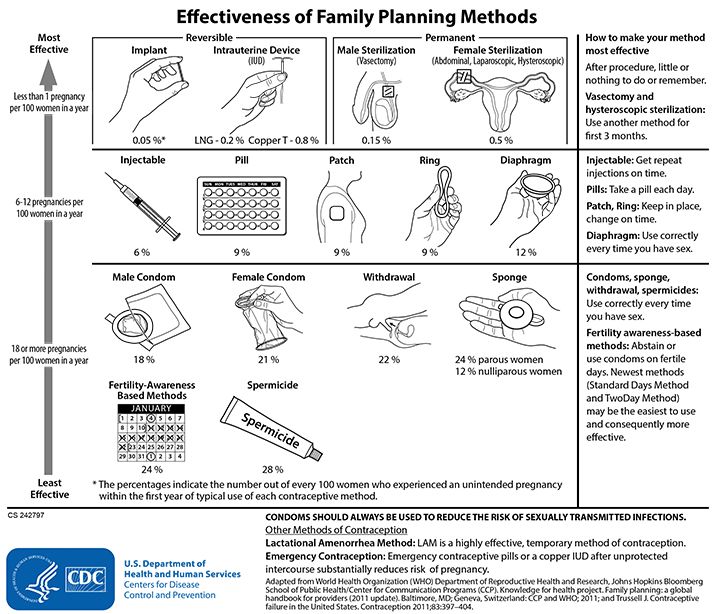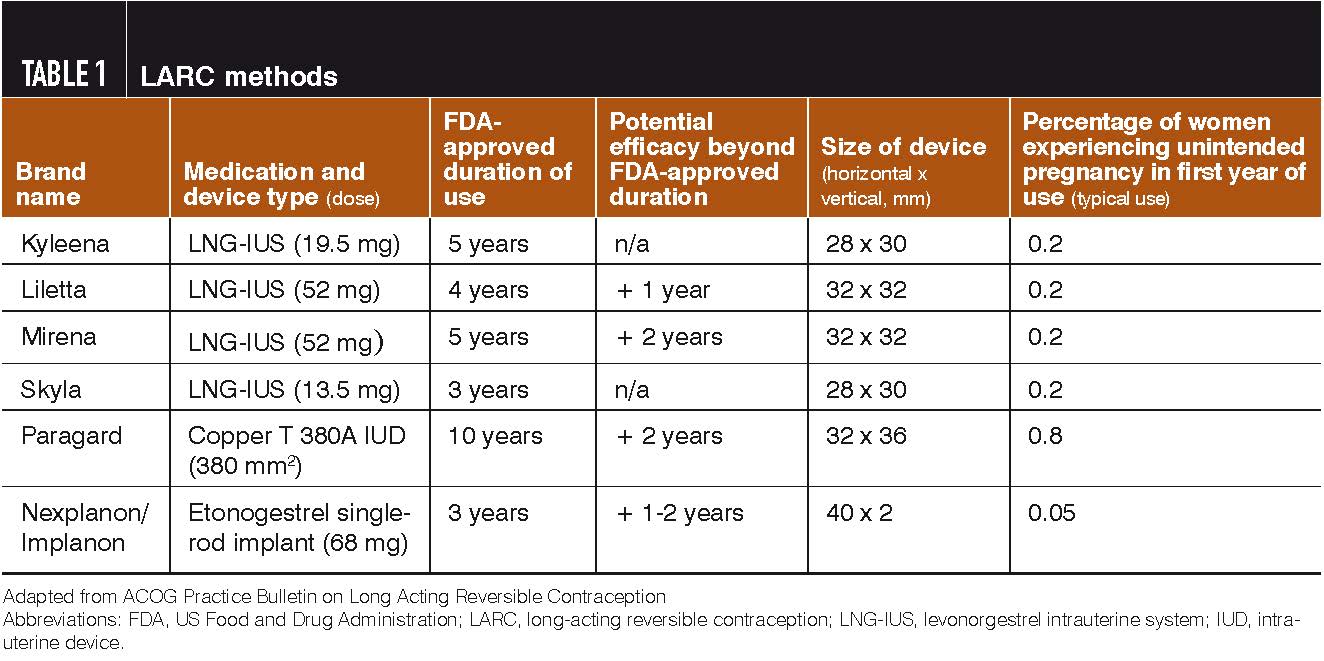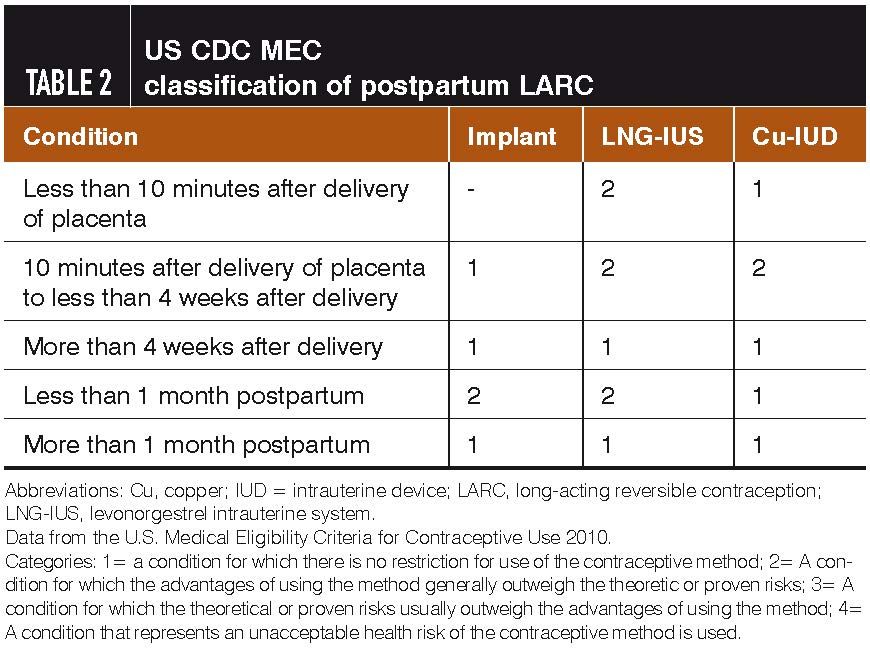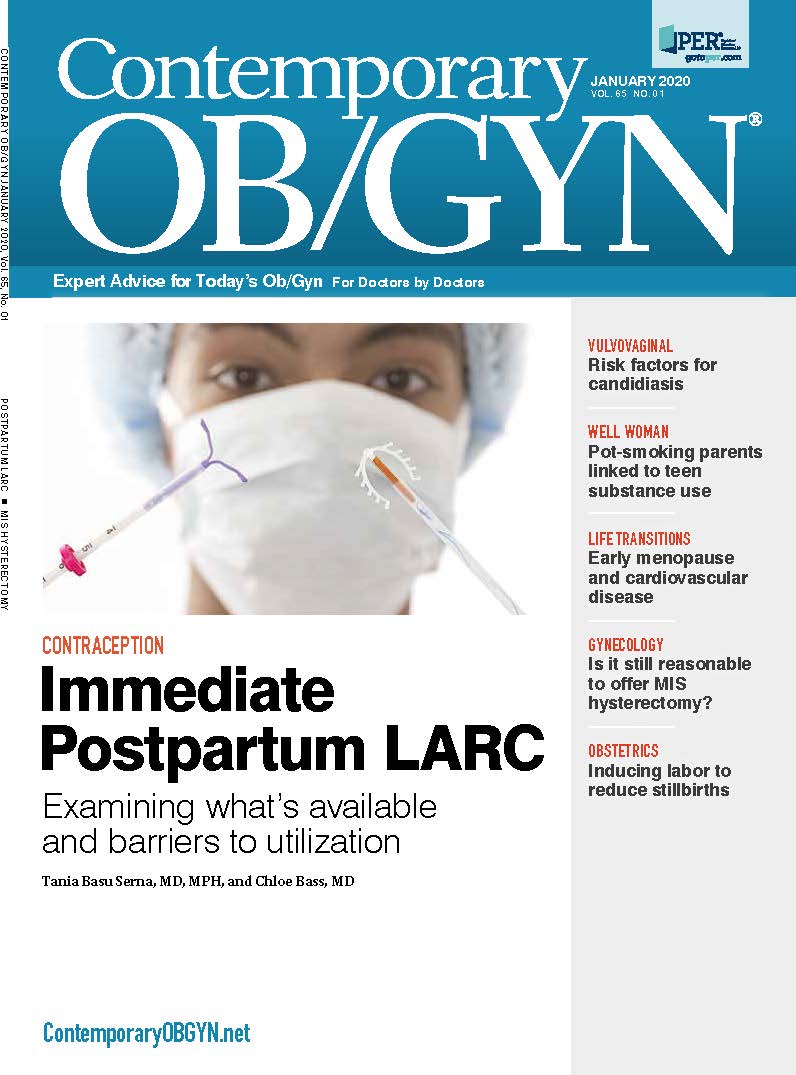Immediate postpartum LARC
Besides routinely offering postpartum LARC to their patients, ob/gyns must advocate for policies that support these devices.

Effectiveness of family planning methods

Initiating a highly effective method of contraception in the immediate postpartum period has several benefits, including assurance that the woman is not pregnant and avoidance of short interpregnancy intervals. Between 40% and 57% of women report having unprotected intercourse before the routine 6-week postpartum visit and ovulation occurs as early as 25 days, putting postpartum women at risk of unintended pregnancy.1,2 Several experts have recommended moving the postpartum visit to 2 weeks instead of 6 weeks because of the high risk of unintended pregnancy. Recently, the American College of Obstetricians and Gynecologists (ACOG) has recommended that women have some contact with their obstetrical provider within the first 3 weeks postpartum.3 However, awaiting the postpartum visit to initiate effective contraception can be problematic as approximately 10% to 40% of women do not attend this visit.3,4
In the first year postpartum, 70% of pregnancies are unintended.5 Unintended and short-interval pregnancies are associated with increased rates of preterm birth and adverse maternal and neonatal outcomes.6 The World Health Organization recommends spacing pregnancies at least 18 months apart and in the United States, the Office of Disease Prevention and Health Promotion continues to aim to reduce the proportion of pregnancies conceived within 18 months of a previous birth, per their Healthy People 2020 objectives.7
Why LARC?
Intrauterine devices (IUDs) and contraceptive implants, also known as long-acting reversible contraceptives (LARC), are the most effective reversible contraceptives and can be safely initiated immediately postpartum. LARCs have the highest continuation rates among reversible methods with effectiveness greater than 99% (Figure 1). The major advantages of LARCs are that they are not user-dependent and return to fertility is rapid after discontinuation. Placement in the postpartum period is associated with higher continuation rates compared with interval placement. ACOG supports immediate postpartum LARC insertion as a best practice.8,9
Table 1

LARC methods available in the United States
Currently there are five IUDs and one contraceptive implant available in the United States.
Copper Intrauterine Device
Paragard is the copper T380A IUD commercially available in the United States. It is US Food and Drug Administration-approved for use up to 10 years but has been shown to be effective up to 12 years.10 The T-shaped device is a base of polyethylene wrapped with copper wire around the stem and arms. Mechanisms of action (MOAs) include inhibition of sperm migration and viability and damage to or destruction of the ovum.11,12 Postfertilization events may occur, but the copper IUD does not disrupt a pregnancy after implantation. It has a reported 1-year failure rate of 0.8 per 100 women. The most-reported adverse events (AE) are abnormal uterine bleeding and pain.13
Levonogestrel intrauterine systems
There are four levonogestrel intrauterine systems (LNG-IUS) currently available in the United States (Mirena, Liletta, Kyleena, Skyla) (Table 1). All are T-shaped and include a polydimethylsiloxane sleeve containing levonorgestrel in the stem. All LNG-IUS have a similar primary MOA: prevention of fertilization by increasing the amount and viscosity of cervical mucus.14,15 Most women who use an LNG-IUS ovulate but experience diminished menstrual bleeding due to the local effect of the levonorgestrel on the endometrium.16 LNG-IUS are not abortifacients and do not disrupt pregnancy.
Contraceptive implant
The etonogestrel contraceptive implant is placed subdermally and consists of an ethylene vinyl acetate copolymer core containing 68 mg of etonogestrel. The single-rod implant is 4 cm in length and 2 mm in diameter and is preloaded in a disposable sterile applicator. The 2001 version of the implant has been updated and was introduced to the United States in 2011.17 The newer implant is radio-opaque with a new inserter designed to prevent deep placement. Its primary MOA is ovulation suppression, but it also thickens cervical mucus and has endometrial effects.18,19 After implant insertion, changes in menstrual patterns are common and include amenorrhea, or frequent, infrequent, or prolonged bleeding. Complications related to implant insertion and removal are rare.

Postpartum LARC safety
ACOG states that immediate postpartum IUD insertion (within 10 minutes after placental delivery in vaginal and cesarean births), should be offered routinely as a safe and effective option for postpartum contraception.9 The Centers for Disease Control and Prevention US Medical Eligibility Criteria (US CDC MEC) classifies immediate postpartum copper IUD insertion as Category 1 (Table 2). Immediate postpartum insertion of LNG-IUS and the contraceptive implant is MEC Category 1 or 2, depending on breastfeeding status (Table 2). Immediate postpartum IUD insertion is contraindicated for women in whom uterine infection, puerperal sepsis, or ongoing postpartum hemorrhage are diagnosed. Immediate postpartum initiation of the contraceptive implant either before hospital discharge or after a hospital stay for birth should be offered routinely as a safe and effective options regardless of breastfeeding status. The US CDC MEC classifies placement of an implant in non-breastfeeding women less than 21 days postpartum as Category 1 and classifies placement for breastfeeding women as Category 2, given theoretical concerns regarding milk production; after 30 days postpartum, it is classified as US MEC Category 1 in breastfeeding women.20
Postplacental IUD perforation and expulsion
Uterine perforation at time of postplacental IUD placement is rare. In a prospective study of 8343 women receiving the Copper T380A at different postpartum timings, only one perforation occurred out of 460 postplacental insertions (0.2%).21 This risk is not greater than with interval IUD insertion.
The rate of postplacental IUD expulsion, on the other hand, is higher than after interval insertion. Reported expulsion rates range from 2% to 27% after vaginal delivery and 0% to 20% after cesarean delivery.22,23 In a large randomized controlled trial (RCT) of postplacental IUD insertion, Chen et al. randomized 102 women to postplacental insertion of the 52-mg LNG-IUS or interval insertion 6 to 8 weeks later. Expulsion was higher with postplacental insertion than with interval insertion. However, 10 of 12 women who experienced expulsion after immediate postpartum placement had a new LNG-IUS inserted and both groups had similar rates of IUS use at 6 months (84% vs. 77%, P = 0.32).24
Another study randomized women to immediate IUD placement at cesarean delivery versus interval placement at
6 weeks postpartum and found that significantly more women in the immediate placement group continued the IUD at 6 months (83% vs. 64%, RR 1.3, CI 1.02-1.66).25 In the interval group, 39% did not obtain the IUD, 25% did not return for the postpartum visit, and 14% either declined the IUD or had an unsuccessful insertion.25 When looking at expulsion rates after postplacental IUD insertion versus after insertions at other postpartum intervals (> 10 min to 48 or 72 hours), data are conflicting. Despite the higher expulsion rate for immediate postpartum IUD placement, evidence from clinical trials and cost-benefit analyses strongly suggest superiority of immediate placement, especially for women at greatest risk of not having recommended postpartum follow-up. Patients should be counseled about the increased expulsion risk, as well as signs and symptoms of expulsion. Given that many women experience barriers to interval LARC placement, advantages of immediate postpartum placement may outweigh disadvantages.
Bleeding
Postplacental IUD insertion does not appear to cause increased vaginal bleeding. A Cochrane review of RCTs comparing immediate postpartum versus delayed insertion of the contraceptive implant found that women who received an immediate postpartum implant had a higher mean number of days of abnormal vaginal bleeding and side effects within 6 weeks postpartum but that did not lead to differences in continuation rates at 6 months.26 There appeared to be little or no difference between the groups in heavy irregular vaginal bleeding or associated severe cramping within 12 months.
Effect on breastfeeding
Given that progesterone withdrawal after delivery of the placenta is thought to trigger lactogenesis, there are theoretical concerns about progestin IUDs and implants preventing onset of milk production. Observational studies suggest they have no effect on lactogenesis, successful initiation and continuation of breastfeeding, or on infant growth and development. The Copper-T lacks hormones and thus is classified MEC Category 1 for immediate postpartum use by breastfeeding women. Data on the immediate postpartum use of LNG-IUS are limited to a secondary analysis of a small RCT of immediate versus delayed postpartum placement, which showed no difference in patient-reported breastfeeding at 6 to 8 weeks and 3 months. However, more women in the delayed placement group reported breastfeeding at 6 months.27 Small numbers limit the ability to draw definitive conclusions from this study.
Given current available evidence, women should be counseled about theoretical risks of reduced duration of breastfeeding with immediate LNG-IUS placement but the majority of evidence has not shown a negative effect on breastfeeding outcomes.28 For this reason, immediate postpartum insertion of an LNG-IUS in breastfeeding women is classified as MEC Category 2.20 Placement of the contraceptive implant in non-breastfeeding women less than 21 days postpartum is Category 1 and placement for breastfeeding women is Category 2; after 30 days postpartum, it is Category 1 in breastfeeding women.20
VTE risk
One of the main considerations for postpartum contraception is risk of venous thromboembolism (VTE), given the already increased risk in this period. The Copper T, LNG-IUS, and implant do not increase risk of VTE and are good options for women with medical problems for which estrogen is contraindicated.
Techniques for postplacental IUD placement
After vaginal delivery, IUD insertion can be performed manually or with a ring forceps. The IUD is removed from the inserter and strings are trimmed to 10 cm. Typically, the strings of the Copper T do not need to be trimmed. The arms of the IUD are gently grasped with the forceps and placed at a slight angle to facilitate placement. The IUD is passed through the cervix to the fundus with the other hand applying downward fundal pressure. Ultrasound guidance can be used to ensure appropriate positioning. At time of cesarean delivery, after delivery of the placenta and uterine tone is achieved, the IUD is placed at the fundus with the inserter, manually or with the ring forceps, and the strings are directed through the cervix. The hysterotomy is then closed in the usual fashion. Formalized training is advisable prior to provision of an immediate postpartum IUD; ACOG instructional videos are available.29
Currently there is insufficient evidence to support routine use of ultrasound for postplacental placement of IUDs, so it is reasonable not to use the technology this setting. If there is a concern about fundal placement of the IUD, an ultrasound can be used to ensure proper positioning. Lack of ultrasound availability should not prohibit provision of postplacental IUD at time of vaginal delivery.28
Follow-up
ACOG now recommends that, ideally, all women have some contact with an obstetrical provider within the first 3 weeks postpartum; the timing of a comprehensive postpartum visit should be individualized and patient centered.3 Assessment of how a patient is doing with her immediate postpartum LARC should be performed. For patients who have had postplacental IUD placement, a speculum exam can be performed to visualize the IUD strings. The strings can be trimmed as they often lengthen. Routine ultrasound surveillance is not recommended.
If incidental displacement of the IUD is diagnosed, removal is not mandated but can be considered after appropriate patient counseling, if desired.28 Patients who receive a postpartum implant should be examined like any other patients with an implant, with verification that the device can be palpated and inspection of insertion site.
Management of lost IUD strings
Inability to visualize IUD strings after postplacental placement ranges from 5% for LNG-IUS placement after vaginal delivery to 44% to 79% for IUD placement during cesarean delivery.25,30,31 If the IUD strings are not visualized or palpated at the external os, it may be necessary to use ultrasound to confirm the intrauterine location. Women who undergo postplacental IUD placement should be counseled that confirmation of the IUD may require ultrasound examination.
Postpartum LARC cost-effectiveness
Several studies have shown that postpartum insertion of LARC typically is more expensive up front but is cost-saving overall because of reductions in future unintended pregnancies. A 2015 cost-effectiveness analysis calculated postpartum IUD placement had an estimated cost savings of approximately $282,540 per 1,000 women over a 2-year period. Higher cost was incurred at time of postplacental IUD placement due to more devices used (in part due to expulsion and replacement), but that was offset by prevention of an additional 88 unintended pregnancies over 2 years per 1,000 women.32 Another model found that immediate insertion of contraceptive implants was associated with a higher cost at insertion ($1,091 per patient for immediate placement vs. $650 per patient for delayed placement, likely due to more implants placed in the immediate group) but was more effective in preventing pregnancies, saving $1,263 per patient.33 This prevented 191 unintended pregnancies per 1,000 women with a total savings of $1,263,000 compared with delayed insertion. One caveat is that savings may depend on payor; a 2009 cost-benefit analysis estimated that a postpartum IUD program for patients with Emergency Medicaid would be costly to individual hospitals with a loss of 70 cents per $1 spent.34 Conversely, the same program funded by the state government would save an estimated $2.94 for every $1 spent. This difference was attributed to the likelihood that the state would cover all costs of future unintended pregnancies but hospitals would not see future profits from same-hospital deliveries.
Challenges and barriers to postpartum LARC utilization
In a 2018 survey of 104 practicing Fellows and Junior Fellows of ACOG, physicians identified lack of access to devices in the hospital, cost or reimbursement issues, and lack of training as perceived barriers to providing immediate postpartum LARC.35 Of those surveyed, only 26.9% were currently offering this service to their patients. Reimbursement can be challenging as compensation for devices and insertion fees are not included in many global payment packages for delivery and postpartum care. Medicaid policies vary widely by state. Policy-level barriers identified in a 2015 survey of 40 Medicaid agencies included lack of accurate understanding of clinical benefits by policymakers; uncertainty about cost-effectiveness, upfront costs, and the overall financial impact of instituting such programs; concerns about making changes to payment methodology from global charges to itemized payments; and competing priorities for Medicaid funds.36
Implementing an immediate postpartum LARC program within an individual institution has similar barriers; Hofler et al. in 2017 interviewed personnel from 10 Georgia hospitals working to establish these programs and found that lack of knowledge, financial concerns, and competing clinical and administrative priorities were roadblocks to program success.37 These programs also require collaboration and buy-in at multiple levels by clinicians, patient care team members, pharmacists, administrators, and billing and electronic health record staff, which can be challenging to coordinate. ACOG recognizes these challenges and provides resources through the Postpartum Contraceptive Access Initiative to assist providers who want to implement a postpartum LARC program at their institution.38
References:
- Connolly A, Thorp J, Pahel L. Effects of pregnancy and childbirth on postpartum sexual function: a longitudinal prospective study. Int Urogynecol J Pelvic Floor Dysfunc. 2005;16:263-267.
- Jackson E, Glasier A. Return of ovulation and menses in postpartum nonlactating women: a systematic review. Obstet Gynecol. 2011; 117:657-662.
- McKinney J, Keyser L, Clinton S, Pagliano C. ACOG Committee Opinion No. 736: Optimizing Postpartum Care. Obstet Gynecol. 2018 Sep;132(3):784-785.
- Danilack VA, Brousseau EC, Paulo BA, Matteson KA, Clark MA. Characteristics of women without a postpartum checkup among PRAMS participants, 2009-2011. Matern Child Health J. 2019 Jan 10. doi: 10.1007/s10995-018-02716-x. [Epub ahead of print]
- White K, Teal SB, Potter JE. Contraception after delivery and short interpregnancy intervals among women in the United States. Obstet Gynecol. 2015;125;1471-1477.
- Conde-Agudelo A, Rosas-Bermudez A, Kafury-Goeta AC. Birth spacing and risk of adverse perinatal outcomes: a meta-analysis. JAMA 2006; 295 (15): 1809-23
- U.S. Office of Disease Prevention and Health Promotion. Available at https://www.healthypeople.gov/2020/topics-objectives/topic/maternal-infant-and-child-health
- Committee on Gynecologic Practice Long-Acting Reversible Contraception Working Group. Committee Opinion No. 642: Increasing Access to Contraceptive Implants and Intrauterine Devices to Reduce Unintended Pregnancy. Obstet Gynecol. 2015 Oct;126(4):e44-e48.
- American College of Obstetricians and Gynecologists’ Committee on Obstetric Practice. Committee Opinion No. 670: Immediate Postpartum Long-Acting Reversible Contraception. Obstet Gynecol. 2016 Aug;128(2):e32-e37.
- Wu JP, Pickle S. Extended use of the intrauterine device: a literature review and recommendations for clinical practice. Contraception 2014; 89: 495-503
- Rivera R, Yacobson I, Grimes D. The mechanism of action of hormonal contraceptives and intrauterine contraceptive devices. Am J Obstet Gynecol. 1999;181:1263-1269.
- Ortiz ME, Coxatta HB. Copper T intrauterine device and levonorgestrel intrauterine syste; biological bases of their mechanism of action. Contraception. 2007;75:S16-S30.
- Godfrey EM, Folger SG, Jeng G, Jamieson DJ, Curtis KM. Treatment of bleeding irregularities in women with copper-containing IUDs: a systematic review. Contraception. 2013;87:549-566.
- Natavio MF, Taylor D, Lewis RA, Blumenthal P, Felix JC, Melamed A, et al. Temporal changes in cervical mucus after insertion of the levonorgestrel-releasing intrauterine system. Contraception. 2013;87:426-431.
- Lewis RA, Taylor D, Natavio MF, Melamed A, Feliz J, Mishell D Jr. Effects of the levonorgestrel-releasing intrauterine system on cervical mucus quality and sperm penetrability. Contraception. 2010;82:491-496.
- Gemzell-Danielsson K, Schellschmidt I, Apter D. A randomized phase II study describing the efficacy, bleeding profile and safety of two low-dose levonorgestrel releasing intrauterine contraceptive systems and Mirena. Fertil Steril. 2012;97:616-622. E1-E3
- Graesslin O, Korver T. The contraceptive efficacy of Implanon: A review of clinical trials and marketing experience. Eur J Contracept Reprod Health Care. 2008;13 Suppl 1 4-12.
- Davies GC, Feng LX, Newton JR, Van Beek A, Coeling-Bennink HJ. Release characteristic, ovarian activity and menstrual bleeding pattern with a single contraceptive implant releasing 3-ketodesestril. Contraception. 1993;47:251-261.
- Croxatto HB. Mechanisms that explain the contraceptive action of progestin implants for women. Contraception. 2002;65:21-27.
- Update to CDCs U.S. Medical Eligibility Criteria for Contraceptive Use 2010: revised recommendations for the use of contraceptive methods during the postpartum period. Centers for Disease Control and Prevention (CDC). MMWR Morb Mortal Wkly Rep. 2011;60:878-883.
- Caliskan E. Ozurk N, Dilbaz S. Analysis of risk factors associated with uterine perforation by intrauterine devices. Eur J Contracept Reprod Health Care. 2003;8(3):150-155.
- Dahlke JD, Terpstra ER, Ramseyer AM, Busch JM, Rieg T, Magann EF. Postpartum insertion of levonorgestrel-intratuerine system at three time periods: a prospective randomized pilot study. Contraception. 2011;84;244-248.
- Celen S, Sucak A, Yildiz Y, Danisman N. Immediate postplacental insertion of intrauterine contraceptive device during cesarean section. Contraception. 2011;84:240-243.
- Chen BA, Reeves MF, Hayes JL, Hohmann HL, Perriera LK, Creinin MD. Postplacetnal or delayed insertion of the levonorgestrel intrauterine device after vaginal delivery: a randomized controlled trial. Obstet Gynecol. 2010;116:1079-1087.
- Levi EE. Stuart GS, Zerden ML, Garrett JM, Bryant AG. Intrauterine device placement during cesarean delivery and continued use 6 months postpartum: a randomized controlled trial. Obstet Gynecol. 2015;126:5-11.
- Sothornwit J, Werawatakul Y, Kaewrudee S, Lumbiganon P, Laopaiboon M. Immediate versus delayed postpartum insertion of contraptive implant for contraption. Cochrane Database Sys Rev. 2017 Apr 22;4.
- Chen BA, Reeves MF, Creinin MD, Schwarz EB. Postplacental or delayed levonorgestrel intrauterine devices insertion and breastfeeding duration. Contraception. 2011;84(5):499-504.
- Whitaker A, Chen BA. Society of Family Planning Guidelines: Postplacental insertion of intrauterine devices. Contraception. 2018;97:2-13.
- American College of Obstetrics and Gynecology. Video on Immediate Postplacental LARC Insertion. Available at https://cfweb.acog.org/district_ii/larc/section4.html
- Glazer AB, Wolf A, Gorby N. Postpartum contraception: needs vs. reality. Contraception. 2011;83(3):238-241.
- Lester F, Kakaire O, Byanugish J, Averbach S, Fortin J, Maurer R, et al. Intracesarean insertion of the copper T380A versus 6 weeks postcesarean: a randomized clinical trial. Contraception. 2015;91(3):198-203.
- Washington CI, Jamshidi R, Thung SF, Naveri UA, Caughey AB, Werner EF. Timing of postpartum intrauterine device placement: a cost-effectiveness analysis. Fertil Steril. 2015;103(1):131-137.
- Gariepy AM, Duffy JY, Xu X. Cost-Effectiveness of Immediate Compared With Delayed Postpartum Etonogestrel Implant Insertion. Obstet Gynecol. 2015 Jul;126(1):47–55.
- Rodriguez MI, Caugher AB, Edelman A, Darney PD, Foster DG. Cost-benefit analysis of state and hospital funded postpartum intrauterine contraception at a university hospital for recent immigrants to the United States. Contraception. 2010; 81(4):304-308.
- Ongoing barriers to immediate postpartum long-acting reversible contraception: a physician survey. Holden EC, Lai E, Morelli SS, Alderson D, Schulkin J, Castleberry NM, McGovern PG. Contracept Reprod Med. 2018 Nov 8;3:23.
- Moniz MH, Dalton VK, Davis MM, et al. Characterization of Medicaid policy for immediate postpartum contraception. Contraception. 2015 Dec;92(6):523-531.
- Hofler LG, Cordes S, Cwiak CA, Goedken P, Jamieson DJ, Kottke M. Implementing immediate postpartum long-acting reversible contraception programs. Obstet Gynecol. 2017 Jan;129(1):3-9.
- ACOG Postpartum Contraceptive Access Initiative. Available at https://pcainitiative.acog.org

Recap on reproductive rights with David Hackney, MD, MS
December 20th 2022In this episode of Pap Talk, we spoke with David Hackney, MD, MS, maternal-fetal medicine physician at Case Western Reserve University and chair of ACOG's Ohio chapter for a full recap of where restrictions on reproductive rights have been and where they're going.
Listen
In this episode of Pap Talk, Gloria Bachmann, MD, MSc, breaks down what it means to be a health care provider for incarcerated individuals, and explores the specific challenges women and their providers face during and after incarceration. Joined by sexual health expert Michael Krychman, MD, Bachmann also discusses trauma-informed care and how providers can get informed.
Listen
No link found between hormonal contraception and clitoral adhesion severity
February 28th 2025A recent study presented at the ISSWSH 2025 Annual Meeting found no significant association between hormonal contraceptive use and the severity of clitoral adhesions, though researchers emphasize the need for further investigation.
Read More
